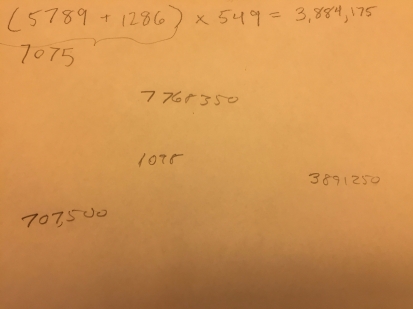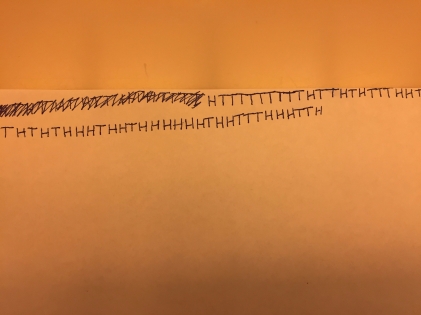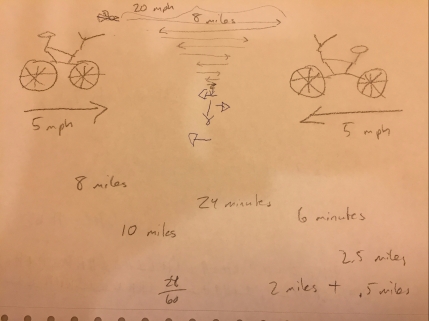The Activities
- Topic: Money. Book: The Story of Money by Maestro. We continued where we left off last time, and got as far as early money in the Americas. My favorite part was the discussion of why paper money caught on better in China than in Europe (the government was more stable in China).
- Topics: Algebra, Arithmetic: I wrote down the equation (5789 + 1286) x 549 = 3,884,175. I used my phone to compute the right hand side. Then I asked them a series of questions: What is the answer if you change 5789 to 5790 (the answer increases by 549)? What if you change 549 to 550? What if you change 549 to 1098? Each time, using my phone, I checked that you got the same answer by evaluating directly vs. evaluating incrementally.

- Topic: Probability: I attempted to teach the kids how to flip a coin properly, and then each kid (and me) spent 5-10 minutes flipping coins and writing down the sequence. Then, I asked several questions: “Do you expect more heads or tails? Is heads more likely after you’ve just gotten three tails in a row? Is heads-tails more likely than heads-heads?” For each one, we counted in our sequences to see whether the results matched the kids’ intuitions.

- Topic: Logic: I drew a picture of two bicycles riding toward each other at 5 mph, starting 10 miles apart, and asked them how long before the bicycles met. Then, I added a bird flying at 20 mph back and forth between the bicycles, turning around and going back whenever is met a bicycle, and asked how far the bird flew before the bikes met.

How Did It Go?
We had four kids this week. It was a pretty good circle, some distractions as always but a lot of good thinking as well.
The Story of Money
This book has been going well, our daughter was able to explain the China vs. Europe paper money difference later that day when we were talking about circle.
Incremental Algebra
The kids did quite well on this activity, many of them were comfortable with parentheses and they didn’t have much problem getting the right answers. By the end they were getting confident enough they thought the checking was a waste of time.
Coin Flip Sequences
When I started asking questions, I got some answers like “more heads after 3 tails in a row” — but I was surprised that after hearing each others’ answers they quickly converged to 50/50 no matter what. So they seem to have a decent grasp on the idea of independence of coin flips. Flipping was kind of hard for them, they really wanted to move their whole hands instead of just their thumbs. For this reason the results were slightly suspect. And of course this is a probability exercise so the results never come out perfect. But by the end I felt pretty confident that some of the kids understood the idea of evaluating probabilities by counting occurrences from a sequence of trials (i.e., statistics). The trickiest part was that if you have a sequence of, say, 5 heads in a row, and you’re counting outcomes after 3 heads in a row, you use this sequence 3 times (first 3, second 3, and final 3).
The Bird and the Bikes
One of the kids got the clever answer to the full question almost immediately. Partly this was because I made it easier by asking the bikes only question first. But still, I was impressed. We also started computing the “brute force” way where we figured out how far the bird flew before meeting the first bike (8 miles). The kids did okay at this too even though it’s a bit tricky.